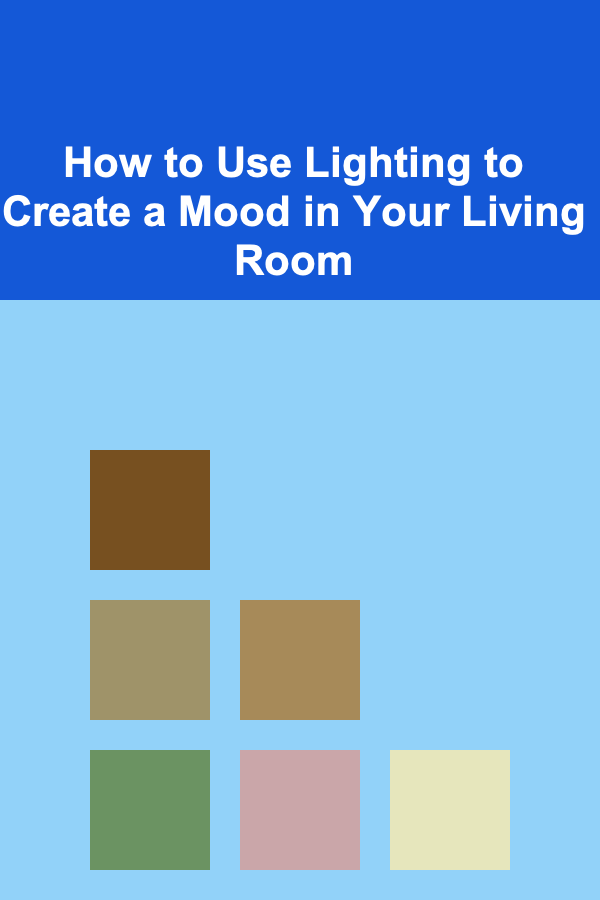
How to Use Lighting to Create a Mood in Your Living Room
ebook include PDF & Audio bundle (Micro Guide)
$12.99$6.99
Limited Time Offer! Order within the next:

Lighting is one of the most essential components of interior design. It not only serves a functional purpose but also plays a pivotal role in shaping the mood of a space. The right lighting can elevate the ambiance of a room, create a sense of comfort, and even influence how we feel in the space. In particular, the living room is often the heart of the home---a space where we relax, entertain, or spend quality time with loved ones. Understanding how to use lighting effectively in the living room can transform it into a dynamic, multi-functional space that suits various needs and occasions.
In this article, we will explore how to use lighting to create different moods in your living room. We will delve into the science behind lighting, the types of lighting fixtures, and how to layer light to enhance both the aesthetics and functionality of the room. By the end of this article, you will have a thorough understanding of how to harness the power of lighting to evoke the perfect atmosphere for any occasion.
The Science Behind Lighting and Mood
Before diving into the specifics of how to use lighting, it's important to understand how lighting influences human emotions and perception. Light affects our mood, productivity, and even physical well-being, making it a powerful tool when used correctly.
The Psychological Impact of Light
Light has a profound effect on the way we feel in a space. Different types of light can evoke different emotional responses. For example, bright, cool light tends to promote alertness and focus, while soft, warm light creates a cozy, relaxed atmosphere. Our brains are wired to respond to light in certain ways, and this response is deeply tied to our circadian rhythm.
- Warm Light: Warm-toned lights (those with a color temperature of around 2700K) are soothing and comfortable. They are often associated with feelings of warmth and relaxation, making them ideal for living rooms where you want to unwind or engage in intimate conversations. This type of lighting can mimic the glow of a setting sun, creating a natural and inviting atmosphere.
- Cool Light: On the other hand, cool-toned light (those with a color temperature above 4000K) tends to be more energizing. It is often used in spaces that require concentration, such as offices or kitchens. However, in a living room, it can be useful for creating a more modern, vibrant look---ideal for moments of activity or when you want to brighten up the room.
The Role of Color Temperature
The color temperature of light is a key factor in setting the mood of a room. Color temperature is measured in Kelvins (K) and refers to the warmth or coolness of a light source. Understanding the different ranges of color temperature will help you choose the right lighting for different moods in your living room.
- Below 3000K (Warm Light): This range of light is ideal for creating a cozy, intimate, and inviting atmosphere. Think of the soft light from a fireplace or candlelight. It is perfect for evening relaxation or when you want to set a romantic or tranquil mood.
- 3000K-4000K (Neutral Light): This range offers a balance between warmth and coolness, making it suitable for general living room lighting. Neutral light is ideal for spaces where you entertain guests, read, or engage in other activities that require clear visibility without harsh brightness.
- Above 4000K (Cool Light): Cool light is bright and crisp, creating a more energizing atmosphere. It's often used in spaces like kitchens and bathrooms but can be used in living rooms when you need bright, task-oriented lighting, such as for reading or when the space is used for more active purposes.
Types of Lighting for Mood Creation
There are three main types of lighting that should be considered when designing the lighting plan for your living room: ambient lighting, task lighting, and accent lighting. Each type serves a unique purpose and plays an important role in creating the desired mood.
1. Ambient Lighting: The Base Layer
Ambient lighting, also known as general lighting, is the primary source of light in a room. It provides uniform illumination and sets the overall mood of the space. Ambient lighting should be soft enough to provide a pleasant atmosphere without causing glare or discomfort.
Common sources of ambient lighting include:
- Ceiling Fixtures: Overhead lights such as chandeliers, flush-mount fixtures, and pendant lights are commonly used to provide general illumination. Dimmable options can give you the flexibility to adjust the intensity of light to suit different moods and occasions.
- Recessed Lighting: Recessed or can lights offer a clean, modern look. When installed in the ceiling, they can provide a wide, even spread of light, making them ideal for living rooms that require subtle, ambient illumination.
- Floor Lamps and Table Lamps: These fixtures provide additional ambient light and can be strategically placed in the room to enhance the mood. Look for lamps with soft, fabric shades that diffuse light gently.
2. Task Lighting: Focused Illumination
Task lighting is designed to illuminate specific areas for activities such as reading, knitting, or working. In the living room, task lighting is typically used to highlight specific areas where activities require more focused light.
Common sources of task lighting include:
- Reading Lamps: These are typically placed next to a sofa or armchair to provide direct, focused light for reading or other activities. A flexible, adjustable reading lamp allows you to direct the light exactly where you need it.
- Floor Lamps: Tall, adjustable floor lamps are perfect for areas where you need task lighting. Choose a lamp with a pivoting head for added flexibility and functionality.
- Table Lamps: A classic addition to side tables, table lamps can also serve as task lighting. Select lamps with adjustable brightness levels to ensure the perfect amount of light for the task at hand.
3. Accent Lighting: Highlighting and Drama
Accent lighting adds depth, drama, and visual interest to a room by highlighting architectural features, artwork, or decorative elements. It's used to create focal points and enhance the aesthetic appeal of the space.
Common sources of accent lighting include:
- Wall Sconces: These fixtures are mounted on the wall and can be used to highlight artwork or architectural features, such as textured walls or sculptural elements. Wall sconces can also be used to create a cozy, intimate atmosphere when installed in pairs.
- Track Lighting: Track lights are highly versatile and can be directed to focus on specific objects, artwork, or architectural features. With the ability to adjust the direction of the light, they offer flexibility in how you illuminate the room.
- LED Strips: LED strip lights can be installed under furniture or along walls to create a subtle, indirect glow. They work well in highlighting features such as bookshelves, cabinets, or even the edges of furniture pieces.
Layering Light for the Perfect Mood
The key to creating a dynamic and inviting living room is layering different types of lighting to enhance the atmosphere. Layering involves combining ambient, task, and accent lighting in a way that provides both functionality and mood.
Layering Techniques
- Start with Ambient Lighting: Begin by installing an ambient lighting fixture, such as a ceiling fixture, recessed lighting, or a floor lamp. This provides the base layer of light for the room.
- Add Task Lighting for Functionality: Depending on the activities that take place in your living room, introduce task lighting. This might include reading lamps, table lamps, or floor lamps with adjustable heads.
- Finish with Accent Lighting: To create visual interest and depth, add accent lighting to highlight key features in the room. This could include wall sconces, track lighting, or LED strips.
By combining these layers of light, you can adjust the intensity and focus of the lighting depending on the time of day, the activity, or the mood you wish to create.
Creating Different Moods in Your Living Room
Now that we've explored the basics of lighting and layering, let's take a look at how to use lighting to create specific moods in your living room.
1. Cozy and Relaxing
To create a cozy, relaxing mood in your living room, aim for warm, soft lighting that encourages comfort and tranquility. Use dimmable light fixtures and opt for warm-toned bulbs (2700K). Place lamps strategically to provide soft pools of light, and use accent lighting to highlight features like artwork or a fireplace. Avoid overly bright or cool-toned lighting that can feel harsh and energizing.
2. Energizing and Bright
For a more energizing atmosphere, especially during the day or when hosting guests, consider using brighter, cooler lighting. Utilize ceiling fixtures or recessed lighting with cool-toned bulbs (4000K or above) to create a vibrant, lively atmosphere. This type of lighting works well in a living room that doubles as an entertainment space. Consider adding task lighting to specific areas to provide functional lighting for activities like games or conversation.
3. Romantic and Intimate
To set a romantic, intimate mood, use low-intensity, warm lighting combined with candles or dimmed table lamps. Avoid harsh overhead lighting, and instead use sconces, floor lamps, and accent lighting to create a soft, enveloping glow. Candles and fairy lights add a magical element to the room, evoking feelings of warmth and closeness.
4. Elegant and Dramatic
If you want to create a sophisticated, dramatic look, consider using a combination of focused accent lighting and striking light fixtures. A chandelier, paired with strategically placed spotlights, can add a touch of glamour and highlight the room's architectural details. Accent lighting can also be used to draw attention to artwork or decorative features, creating an elegant focal point in the space.
Conclusion
Lighting is an incredibly versatile tool when it comes to creating mood and atmosphere in the living room. By understanding the science behind light, choosing the right types of lighting, and layering light in a thoughtful way, you can create a space that adapts to your needs and preferences. Whether you want to relax, entertain, or create a romantic ambiance, the right lighting can help you set the perfect tone for any occasion.
With careful planning and consideration of how different types of lighting impact mood, you can transform your living room into a dynamic, welcoming space that is both functional and beautiful. By experimenting with various lighting techniques and adjusting them to suit different times of the day or different activities, you will be able to master the art of using lighting to create the perfect mood in your living room.

How to Improve Your Home Security After a Recent Break-in
Read More
How to Incorporate Task Lighting into Your Home's Design
Read More
How to Prepare Your House to Let for New Tenants
Read More
How to Turn Your Crafting Hobby into a Profitable Side Hustle from Home
Read More
Mastering Cloud Systems Engineering: A Comprehensive Guide to AWS
Read More
Cultivating Discipline and Self-Control: A Comprehensive Guide
Read MoreOther Products

How to Improve Your Home Security After a Recent Break-in
Read More
How to Incorporate Task Lighting into Your Home's Design
Read More
How to Prepare Your House to Let for New Tenants
Read More
How to Turn Your Crafting Hobby into a Profitable Side Hustle from Home
Read More
Mastering Cloud Systems Engineering: A Comprehensive Guide to AWS
Read More